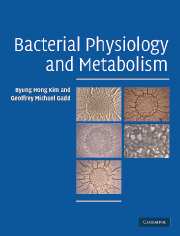Book contents
- Frontmatter
- Contents
- Preface
- 1 Introduction to bacterial physiology and metabolism
- 2 Composition and structure of prokaryotic cells
- 3 Membrane transport – nutrient uptake and protein excretion
- 4 Glycolysis
- 5 Tricarboxylic acid (TCA) cycle, electron transport and oxidative phosphorylation
- 6 Biosynthesis and microbial growth
- 7 Heterotrophic metabolism on substrates other than glucose
- 8 Anaerobic fermentation
- 9 Anaerobic respiration
- 10 Chemolithotrophy
- 11 Photosynthesis
- 12 Metabolic regulation
- 13 Energy, environment and microbial survival
- Index
- References
3 - Membrane transport – nutrient uptake and protein excretion
Published online by Cambridge University Press: 05 September 2012
- Frontmatter
- Contents
- Preface
- 1 Introduction to bacterial physiology and metabolism
- 2 Composition and structure of prokaryotic cells
- 3 Membrane transport – nutrient uptake and protein excretion
- 4 Glycolysis
- 5 Tricarboxylic acid (TCA) cycle, electron transport and oxidative phosphorylation
- 6 Biosynthesis and microbial growth
- 7 Heterotrophic metabolism on substrates other than glucose
- 8 Anaerobic fermentation
- 9 Anaerobic respiration
- 10 Chemolithotrophy
- 11 Photosynthesis
- 12 Metabolic regulation
- 13 Energy, environment and microbial survival
- Index
- References
Summary
Microbes import the materials needed for growth and survival from their environment and export metabolites. As described in the previous chapter, the cytoplasm is separated from the environment by the hydrophobic cytoplasmic membrane, which is impermeable to hydrophilic solutes. Because of this permeability barrier exerted by the phospholipid component, almost all hydrophilic compounds can only pass through the membrane by means of integral membrane proteins. These are called carrier proteins, transporters or permeases (a website devoted entirely to transport can be found at www-biology.ucsd.edu/∼msaier/transport/).
Solute transport can be classified as diffusion, active transport or group translocation according to the mechanisms involved. Diffusion does not require energy; energy is invested for active transport; and solutes transported by group translocation are chemically modified during this process. Some solutes are accumulated in the cell against a concentration gradient of several orders of magnitude, and energy needs to be invested for such accumulation.
Ionophores: models of carrier proteins
There are two models which explain solute transport mediated by carrier proteins: the mobile carrier model and the pore model. The solute binds the carrier at one side of the membrane and dissociates at the other side according to the mobile carrier model, while the pore model proposes that the carrier protein forms a pore across the membrane through which the solute passes. A certain group of antibiotics can make the membrane permeable to ions. These are called ionophores and are useful compounds to assist the study of membrane transport.
- Type
- Chapter
- Information
- Bacterial Physiology and Metabolism , pp. 35 - 59Publisher: Cambridge University PressPrint publication year: 2008



